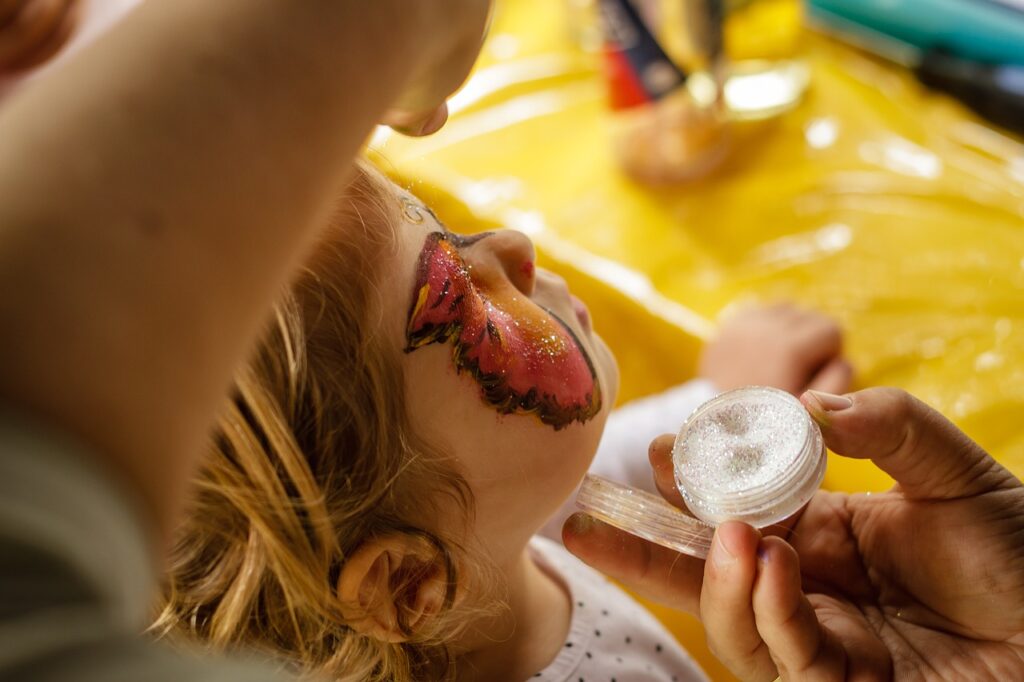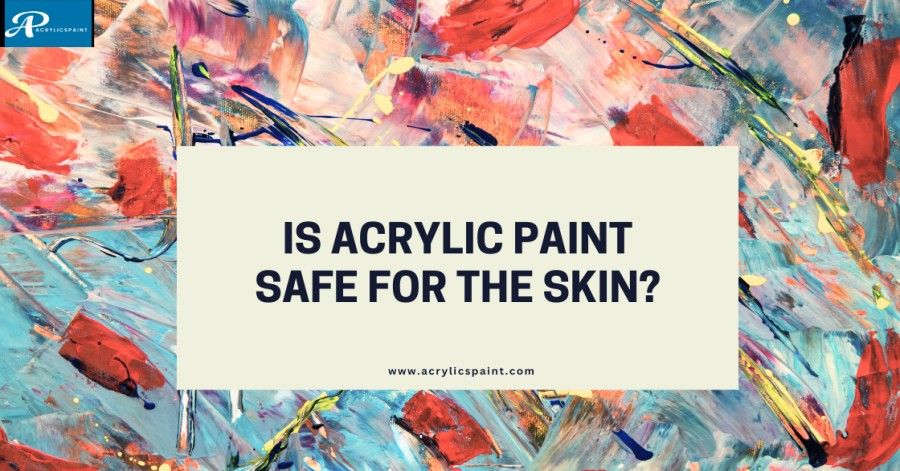Is acrylic paint safe for skin? Acrylic paint has long been celebrated for its vibrant colours in various artistic endeavours. However, when applied directly onto the skin, questions about safety naturally arise. Is acrylic paint safe for the skin? Can it be used for body painting without causing harm? This article will delve into these queries, exploring the potential risks and ways to make acrylic paint skin-safe.
Is Acrylic Paint Safe for Skin?
The primary concern regarding using acrylic paint on the skin is its toxicity. Most traditional acrylic paints contain chemicals and pigments that are not intended for direct contact with the skin. Continuous exposure to these substances can cause irritation, allergic reactions, and even long-term health issues.

Toxicity of Acrylic Paint
Acrylic paints often contain chemicals like formaldehyde, ammonia, and heavy metals such as cadmium and lead. These substances can penetrate the skin and enter the bloodstream, leading to adverse health effects. Additionally, some pigments used in acrylic paints are known to be dangerous or allergenic.
What Kind of Paint is Safe for Face Painting?
When considering face painting, safety should be paramount. Opting for paints formulated explicitly for the face and body is essential to minimize the risk of skin irritation and allergic reactions. Water-based face paints, often labelled as non-toxic and allergy-free, are the preferred choice due to their gentle formulation and ease of removal with water and soap. So, can you put acrylic paint on your face? It’s not recommended, as acrylic paints are not designed for skin use and can cause adverse reactions.
Exploring Safer Alternatives
Water-based face and body paints offer an excellent option for those seeking safer alternatives to traditional acrylic paints. These paints are formulated to be gentle on the skin, free from toxic chemicals, and easy to remove. Natural pigments derived from plants or minerals can provide a safe and eco-friendly alternative for temporary body art.

Is Oil Paint Safe for Skin?
While renowned for its rich colours in traditional art mediums, oil paint is only suitable for some skin applications. Oil-based paints contain toxic substances and solvents that can be absorbed through the skin, leading to irritation, allergic reactions, and long-term health risks. To protect the skin from harm, it’s essential to avoid using oil paints for face and body painting.
Is Spray Paint Bad for Your Skin?
Spray paint, commonly used for graffiti and other outdoor art projects, is not intended for use on the skin and can pose significant health risks. Inhalation of spray paint fumes can irritate the internal skin, while direct contact with the skin can cause irritation, chemical burns, and allergic reactions. It’s crucial to avoid using spray paint on the skin and opt for safer alternatives for body painting.
Best Body and Face Paint
When selecting the best body and face paint for your artistic endeavours, prioritize safety and quality. Avoid using water-resistant paints. Rather, use water-based paints formulated explicitly for the face and body, ensuring they are non-toxic, non-allergenic, and easy to remove. Consider reputable brands that ensure safety and offer a wide range of vibrant colours to unleash your creativity without compromising skin health.
Making Acrylic Paint Safe for Skin
How to Make Acrylic Paint Safe for Skin
While conventional acrylic paints are not safe for direct skin application, there are ways to make them safer:
- Choose Skin-Safe Paints: Look for acrylic paints labelled as non-toxic and formulated explicitly for body painting. These paints are free from harmful chemicals and safe for skin contact.
- Mix with Mediums: Mix acrylic paint with skin-safe mediums like glycerin or aloe vera gel to create a smoother consistency and reduce the risk of skin irritation.
- Test on a Small Area: Before applying acrylic paint to a larger skin area, perform a patch test on a small, inconspicuous area to check for any adverse reactions.
Step-by-Step Guide: Mixing Skin-Safe Acrylic Paint And Paints that are safe for skin?
Creating your own skin-safe acrylic paint mixture can be a rewarding and safe way to indulge in body painting. Here’s a simple step-by-step guide:
Materials Needed
- Skin-safe acrylic paint (non-toxic, formulated explicitly for body painting)
- Skin-safe medium (such as glycerin or aloe vera gel)
- Mixing palette or container
- Mixing tools (brushes, palette knives, or spatulas)
- Water (for adjusting the consistency, if necessary)
Step 1: Choose Your Colors
Select the skin-safe acrylic paint colours you wish to use for your body painting design. Ensure that the paints are labelled as non-toxic and suitable for direct skin contact.
Step 2: Prepare Your Workspace
Set up your workspace in a well-ventilated area with access to water and cleaning supplies. Lay down protective coverings to prevent spills and make cleanup easier.
Step 3: Mix Paint and Medium
Squeeze out the desired amount of skin-safe acrylic paint on a mixing palette or container. Add skin-safe media, such as glycerin or aloe vera gel, to the paint.
Step 4: Blend Thoroughly
Blend the paint and medium thoroughly using a mixing tool until you achieve a smooth and creamy consistency. Ensure the medium is evenly mixed into the paint to create a skin-safe mixture.
Step 5: Test Consistency
Dip a brush or finger into the paint mixture and test the consistency on a small skin area. Adjust the mix as needed by adding more paint or medium to achieve the desired texture and coverage.
Step 6: Begin Body Painting
Once you’re satisfied with the consistency of the paint mixture, you’re ready to start body painting! Use brushes, sponges, or your fingers to apply the paint onto the skin, creating your desired design or artwork.
Step 7: Allow to Dry
Allow the painted design to air dry completely before touching or applying additional layers. Depending on the thickness of the paint layers, drying time may vary.
Step 8: Seal the Design (Optional)
Seal your body painting with a skin-safe spray or powder to ensure it lasts a long time without smudging or fading.
Step 9: Clean Up
Once you’ve finished body painting, thoroughly clean your brushes, mixing tools, and workspace with soap and water. Remove acrylic paint from the skin using gentle cleansers or makeup removers.
How to Seal Body Paint
Once your masterpiece is complete, sealing the body paint is essential to ensure its longevity and prevent smudging or fading. Consider using a body paint sealer or setting powder explicitly designed for use on the skin. Apply a thin, even layer of sealer over the painted area using a clean brush or sponge, ensuring complete coverage. Allow the sealer to dry completely before touching or rubbing the painted surface.
Conclusion
While acrylic paint is a fast-drying and versatile medium made of pigment suspended in acrylic polymer emulsion, offering vibrant colours, it’s essential to prioritize safety when using it on the skin. Conventional acrylic paints are not intended for direct skin contact and can pose health risks.
However, by opting for acrylic paint safe for skin alternatives and taking necessary precautions, you can enjoy the creative possibilities of body painting without compromising your well-being. Remember, it’s always better to err on the side of caution regarding skin health. Prioritize safety, experiment responsibly, and unleash your creativity with peace of mind.














